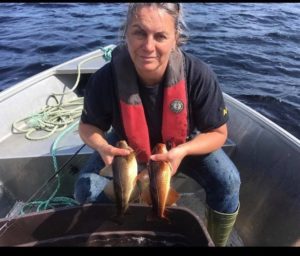Something spooky is lurking in our oceans
Many of us know the feeling of casting a rod off a dock on a warm summer evening. Others can appreciate fish as part of a delicious and nutritious meal. And for some in Canada, fishing is an important part of their livelihood.
That’s why it’s alarming when we see images of sea turtles, fish, seabirds, sharks and even whales swimming through a sea of garbage or becoming entangled in fishing nets meant for other species.
But there’s another type of pollution that has been silently harming these same animals while destroying habitat and posing a safety hazard to fishers and recreational boaters. The culprit: ghost gear.
So, what is ghost gear? It’s abandoned, lost or discarded fishing gear that haunts our ocean long after it’s used. It often ends up abandoned because of bad weather or accidental displacement by other boats or fishers. In the Northwest Atlantic, it’s estimated that lobster fishers lose up to two per cent of their traps every year, while in the Pacific Ocean, ghost gear makes up 46 per cent of the Great Pacific Garbage Patch.
A lot of fishing gear is made from plastic, which takes a long time to break down, so it can entangle marine wildlife for years to decades. When ghost gear finally does break down, it can release microplastics that can be ingested by marine life.
It’s easy to say “let’s get — and keep — ghost gear out of the water,” but doing so is a bit more complicated. It involves using cutting-edge technology to find the gear, working with the fishing community to retrieve it, finding businesses to recycle, repurpose or dispose of it, and making improvements to regional policy and management practices. (Currently, regulations make it difficult for ships to use modified/lower impact gear and there are strict standards on how to collect discarded gear.) Dealing with ghost gear also means using ecological, fisheries and Indigenous knowledge, all while working respectfully within traditional Indigenous territories.

The good news is that the federal government recently committed $8.3 million to fund 26 ghost gear projects over the next two years. Additionally, a diverse group, including Indigenous organizations, ENGOs, fishery unions, academics and industry consultants, recently formed the Fishing Gear Coalition of Atlantic Canada (FGCAC). WWF-Canada, through the FGCAC, then funded a report to understand the extent of ghost gear loss in the Maritimes and how to address it.
In Southern Labrador, we’re also working with the NunatuKavut Community Council to find and retrieve ghost gear in and around the Gilbert Bay Marine Protected Area (MPA), where a specialized population of Atlantic cod, known as golden cod, are in decline despite protections. Working with the Marine Institute (Memorial University of Newfoundland) and Fisheries and Oceans Canada, we’re bringing together scientific and Indigenous knowledge, as well as fishing technology to implement collection days for end-of-life gear, low-impact recycling and disposal systems for rope and traps, and an Extended Producer Responsibility program.
It’s no easy feat, but these projects will help make our oceans a little less spooky for their inhabitants and others who depend on them.

